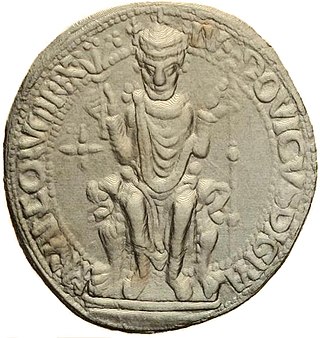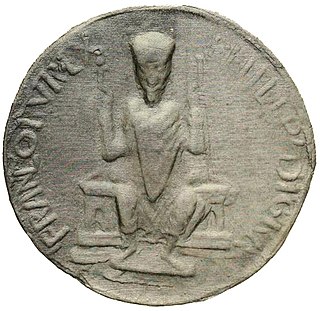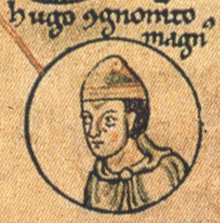Related Research Articles

Adhemarde Monteil was one of the principal figures of the First Crusade and was bishop of Puy-en-Velay from before 1087. He was the chosen representative of Pope Urban II for the expedition to the Holy Land. Remembered for his martial prowess, he led knights and men into battle and fought beside them, particularly at the Battle of Dorylaeum and Siege of Antioch. Adhemar is said to have carried the Holy Lance in the Crusaders’ desperate breakout at Antioch on 28 June 1098, in which superior Islamic forces under the atabeg Kerbogha were routed, securing the city for the Crusaders. He died in 1098 due to illness.

Pope Urban II, otherwise known as Odo of Châtillon or Otho de Lagery, was the head of the Catholic Church and ruler of the Papal States from 12 March 1088 to his death. He is best known for convening the Council of Clermont which ignited the series of Christian military expeditions known as the Crusades.

Louis VI, called the Fat or the Fighter, was King of the Franks from 1108 to 1137. Like his father Philip I, Louis made a lasting contribution to centralizing the institutions of royal power. He spent much of his twenty-nine-year reign fighting either the "robber barons" who plagued the Ile de France or Henry I of England for his continental possession of Normandy. Nonetheless, Louis VI managed to reinforce his power considerably, often resorting to force to bring lawless knights to justice, and was the first member of the house of Capet to issue ordonnances applying to the whole of the kingdom of France.

Philip I, called the Amorous, was King of the Franks from 1060 to 1108. His reign, like that of most of the early Capetians, was extraordinarily long for the time. The monarchy began a modest recovery from the low it had reached during the reign of his father, Henry I, and he added the Vexin region and the viscountcy of Bourges to his royal domaine.

The Council of Clermont was a mixed synod of ecclesiastics and laymen of the Catholic Church, called by Pope Urban II and held from 17 to 27 November 1095 at Clermont, Auvergne, at the time part of the Duchy of Aquitaine.

Hugh, called the Great was the first count of Vermandois from the House of Capet. He is known primarily for being one of the leaders of the First Crusade. His nickname Magnus is probably a bad translation into medieval Latin of an Old French nickname, le Maisné, meaning "the younger", referring to Hugh as younger brother of King Philip I of France.
Fulcher of Chartres was a priest who participated in the First Crusade. He served Baldwin I of Jerusalem for many years and wrote a Latin chronicle of the Crusade.
The Council of Piacenza was a mixed synod of ecclesiastics and laymen of the Roman Catholic Church, which took place from March 1 to March 7, 1095, at Piacenza.

Bertrade of Montfort, also known by other names, was a Norman noble from the House of Montfort. She was countess of Anjou (1089–1092) through her first marriage to Fulk the Rude and then queen consort of France (1092–1108) through her initially bigamous marriage to Philip I. Condemned in her era's ecclesiastical histories, she played a role in the popularization of pigache footwear and founded a daughter house of Fontevraud Abbey at Hautes-Bruyeres.

The Archdiocese of Reims or Rheims is a Latin Church ecclesiastic territory or archdiocese of the Catholic Church in France. Erected as a diocese around 250 by Sixtus of Reims, the diocese was elevated to an archdiocese around 750. The archbishop received the title "primate of Gallia Belgica" in 1089.

The Diocese of Beauvais, Noyon, and Senlis is a Latin Church ecclesiastical territory or diocese of the Catholic Church in France. The diocese encompasses the department of Oise in the region of Hauts-de-France. The diocese is a suffragan of the metropolitan Archdiocese of Reims. The current bishop is Jacques Benoit-Gonnin, appointed in 2010.

The Archdiocese of Aix-en-Provence and Arles is a Latin Church ecclesiastical territory or archdiocese of the Catholic Church in France. The archepiscopal see is located in the city of Aix-en-Provence. The diocese comprises the department of Bouches-du-Rhône, in the Region of Provence-Alpes-Côte d'Azur. It is currently a suffragan of the Archdiocese of Marseilles and consequently the archbishop no longer wears the pallium.
Geoffrey of Vendôme was a French Benedictine monk, writer and cardinal. He was born and died at Angers.

The Diocese of Amiens is a Latin Church diocese of the Catholic Church in France. The diocese comprises the department of Somme, of which the city of Amiens is the capital. In 2022 it was estimated that there was one priest for every 6,916 Catholics in the diocese.
Hugh of Die was a French Catholic bishop.

The Diocese of Mende is a Latin diocese of the Catholic Church in France. The diocese covers the department of Lozère.

The Archdiocese of Clermont is a Latin archdiocese of the Roman Catholic Church in France. The diocese comprises the department of Puy-de-Dôme, in the Region of Auvergne. The Archbishop's seat is Clermont-Ferrand Cathedral. Throughout its history Clermont was the senior suffragan of the Archdiocese of Bourges. It became a metropolitan see itself, however, in 2002. The current archbishop is François Kalist.
The army of Hugh the Great was formed after the Council of Clermont, led by Pope Urban II in November 1095. Hugh, son of Henry I of France, and his wife Anne of Kiev, was Count of Vermandois, de jure uxoris, due to his marriage to Adelaide of Vermandois. In August 1096, Hugh and his small army left France in prima profectione, the first army of the third wave to leave France, and travelled to Bari, Italy, and then crossed the Adriatic Sea to the Byzantine Empire, in an armada commanded by Arnout II, Count of Aarschot. When Hugh entered Constantinople, he carried a Vexillum sancti Petri, a banner given to him by the pope, Hugh being the last such noble to carry the banner.

The Gesta Francorum Iherusalem peregrinantium is a Latin chronicle of the First Crusade written on 1101, 1106, 1124 until 1127 by Fulcher of Chartres. He was a priest who participated in the First Crusade. He served Baldwin I of Jerusalem for many years, and wrote a chronicle of the Crusade, writing in Latin.
References
- Gobry, Ivan (2003). Histoire des Rois de France.